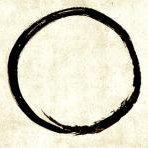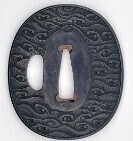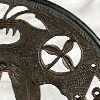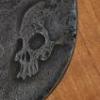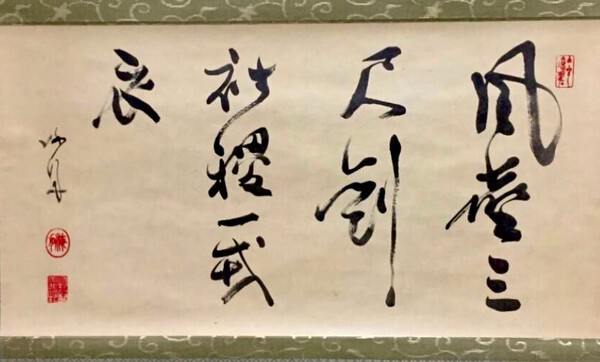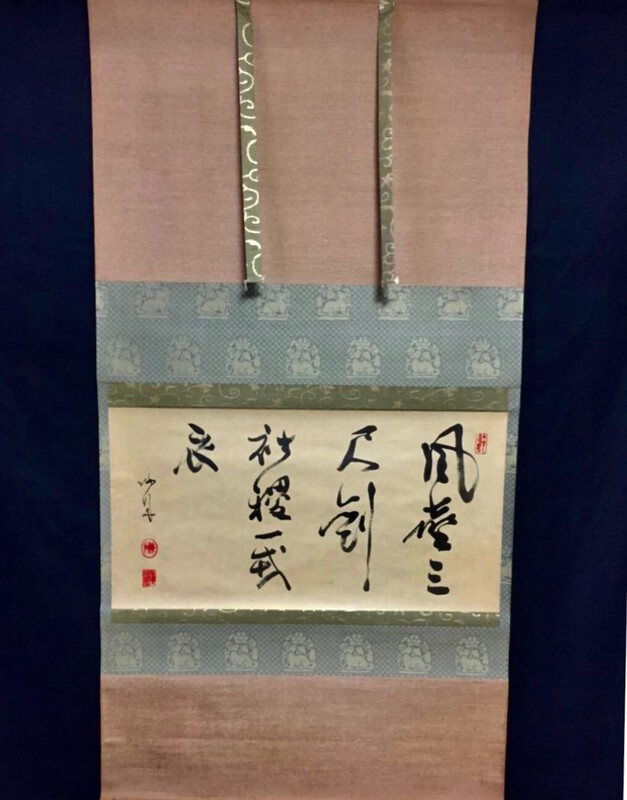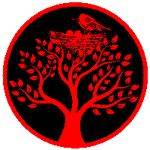All Activity
- Past hour
-
Minh, do you see the gold foil clearly? To me, it looks like a brass HABAKI that was gold-plated. It is important to remove any oil that may have gathered inside the HABAKI to prevent the build-up of Verdigris.
-
Need Translation of WWII Samurai Sword Tang Symbols
Ashley Le Boydre replied to Isley's topic in Translation Assistance
G'Day All, Can someone please help me with this date on my sword. I know it is 1942. But ai would like to know what exactly what the top two and bottom two Kenji symbols are please. Regards Ashley -
Good morning Rob, Thank you for confirming that there are three bands under the leather cover. It reminds me of the illustration in Sword and Same of the type of Tsuka used for Tameshigiri by the Yamada family. Also in the 1980’s, when Yoshihara Yoshindo created a blade to test the famous Sasakibara Kenkichi “Kabutowari performed in front of the young Emperor Meiji”, the swordsman Kawabata Terutaka asked for a similar three band Tsuka to be made. As for the length of the Tsuka being disproportionate, I have seen one Ryuha at the Meiji Jingu Embu using a longer than normal Tsuka. In the current Gendai Budo, the Bokuto used by some of the groups affiliated to the chaps in black, who shall not be named is disproportionately longer.
-
Hello - hoping to get some input on this tsuba's nakago-ana. Is the shape unusual? Given the standard size/shape of a typical sword's tang, this shape seems strange. Thoughts?
- Today
-
Rather strange. At first I thought of a bonsai tree - but without a bowl? Is there something on the reverse wich could clearify the motif?
-
The root part looks very like ginseng, but the leaves are wrong. There is always a good chance that the artist wasn’t that good at depicting plants, and just went with the space available.
-
It’s a very good deal. The sword has several strong points: 1. It hasn’t been shortened (many katana have) 2. It is healthy (many katana are polished down) 3. It is both signed and dated (many swords are not) 4. It has NBTHK papers that attest to the signature 5. The price is attractive relative to its value For a first sword? I strongly doubt you could do better. Why hasn’t it sold (after only a few days, by the way)? Because it’s holiday season. Because this is not a market with millions of buyers. Because those who recognise this as a good deal might have no budget for swords at the moment. Because people have other expenses at the moment. And so on…..
-

Council
Stephen replied to Pritajeni1's topic in Sword Shows, Events, Community News and Legislation Issues
Mr RR may I call you R? You come to the premiere sword study group asking about a katana which it cannot be because it's too short then you were told that it is a fake not even a good copy and you get upset saying how do you know, we have spent many years learning time and money to tell the difference. I hope your heart is not broken when you find out it is false sword. On this website there is many listed sellers you should search those websites and see what a real sword looks like. Best of luck Stephen -
Rust only forms on iron, it's advisable to clean the inside of a Habaki with tissue to remove accumulated gunk.
-
Hi, I’m a bit concerned about this habaki. Its a gold foiled one. The inside seem to developed this but I’m not sure its rust or just normal patina for antique Habakai .
-
Masuda joined the community
-
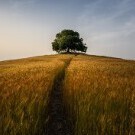
Kanenobu Katana (NBTHK Tokubetsu Hozon)
Schneeds replied to Matthew S's topic in Swords and Edged Weapons
Congrats to the new owner. I didn't think it would last long at that price -
on hold
-
wow, incredible work @Jussi Ekholm! I actually see some of my swords in here - row 14257 for example Also, you can add koshirae made in 2025 to line 5817 ko-fujishima
-
Thanks all for the info and links, looking forward to reading them in more depth. I feel like Ive learned more about identifying hada etc here than anywhere else before After looking at the info on the Sesko page I agree I think you are right, I don't see a turn back either. Ill post some better photos of the nakago tomorrow. Thank you all again, Edward
-
If Grev has not made a commitment to purchase this, I would like to. I don't want to step on anyone's toes, but if it is still available, I will buy it. Thanks, Kevin
-

Kobayashi Taigen, Zen Calligraphy of "Ichi" (一)
Iaido dude replied to Iaido dude's topic in Other Japanese Arts
Nothing in the MFA Boston. I keep looking at art gallery and auction sites. Eventually, something will click and the clue(s) will lead me to the translation. Most of the artists repeated the same composition and calligraphy numerous times. And sometimes many times. - Yesterday
-
I recently acquired this new kakejiku of a splendid calligraphy work by Katsu Kaishū that inspires my iaido practice. I just managed to finish the translation; the translation of the last 5 characters was not indicated on the accompanying kakejiku-bako. My wife recognized the two verses that Katsu brushed verbatim from historical Chinese poetry. Then it became a simple matter of obtaining that translation. Katsu Yasuyoshi (勝 安芳; 1823-1899), born Katsu Yoshikuni (勝 義邦), best known by his nickname Katsu Kaishū (勝海舟筆), was a Japanese statesman, naval engineer and military commander during the late Tokugawa shogunate and early Meiji period. An advocate of modernization and westernization, he eventually rose to occupy the position of commissioner (Gunkan-bugyō) in the Tokugawa navy and was a chief negotiator of the bakufu. As a major Tokugawa commander during the Boshin War, he is particularly known for his bloodless surrender of Edo to Imperial forces, which was co-negotiated with his compatriot and fellow calligrapher Yamaoka Tesshu. As a calligrapher, he is particularly recognized for his highly refined cursive script with examples including a pair of 6-panel byobu screens and individual calligraphic works, being well-versed in the Chinese classics, poetry, and the martial arts. In the work below, Katsu brushed two 5-character verses of "Revisiting Zhaoling" by the Tang Dynasty poet Du Fu (杜甫): "A three-shaku sword in the wind dust, a military uniform for the country" (風塵三尺剣, 社稷一戎衣). It expresses praise for the heroic role of the military in the birthing of a prosperous country, which is in keeping with the Japanese Bushido warrior culture. The imagery that Du Fu paints is of a great military leader expertly wielding a powerful sword to whip up "wind dust" (this is a very visual expression) and thereby produce the conditions of land and agriculture (i.e. "country") that founded the Tang Dynasty. There is a very masculine and martial sentiment in these verses. Du Fu's works came to be hugely influential in both Chinese and Japanese literary culture. Of his poetic writing, nearly fifteen hundred poems have been preserved over the ages. He has been called the "Poet-Historian" and the "Poet-Sage" by Chinese critics. A three-shaku (35.8 cm) sword is generally associated with the Odachi or Nodachi, a long and imposing weapon sometimes used on the battlefield (my practice katana are considered long at 2.45-2.5 shaku). They were also used in ceremonies, as symbols of status, or as offerings to deities. In Zhaoling, there is a monument to the exploits of the Tang dynasty military forces. From his childhood, Katsu learned swordsmanship from the famous teacher Otani Nobutomo. He also studied under Shimada Toranosuke, a skilled swordsman who influenced him by emphasizing Zen practice alongside kenjutsu. He studied at Ushijima Kofuku-ji temple in Tokyo. Kaishū held a license from the Jikishinkage-ryu Kenjutsu school.
-

Council
Rivkin replied to Pritajeni1's topic in Sword Shows, Events, Community News and Legislation Issues
What can I say, I also suffer from the temptation to discovery once in a lifetime treasure and it can be hard to accept I miss more often than land a score. -

Kobayashi Taigen, Zen Calligraphy of "Ichi" (一)
jawob replied to Iaido dude's topic in Other Japanese Arts
That's a bummer. Try the Museum of Fine Art Boston -
well hurry up and buy it hahahahah
-

Kobayashi Taigen, Zen Calligraphy of "Ichi" (一)
Iaido dude replied to Iaido dude's topic in Other Japanese Arts
I contacted John a while back to do the translation for a fee, but he seemed to get confused about it and sent me a translation for another work that was already published and previously translated. After that he stopped replying. Kushner Roshi also tried to contact him on my behalf, but that effort seems not to have been fruitful either. -
The plant depicted is 樅 - momi - Japanese fir. see: https://www.dropbox.com/scl/fi/gew1fwujq25us4bpahzst/FHJ.pdf?rlkey=xqwem1jg9d243ej1wmub7a0hr&st=l12r1vch&dl=0
-
Thanks. I'm trying to figure out if the last 2 kanji on my tanto could correspond to 吉日. I clearly see the 日, but the 吉 is less obvious. Could what can be seen be interpreted as part of the kanji that denotes 1308 or is all that information represented in the early characters? I see the 徳治 higher up for the era. I'm not sure what the 3 parallel lines denote and if an extra character is needed to complete the date. Not having a clearer image isn't helping.






